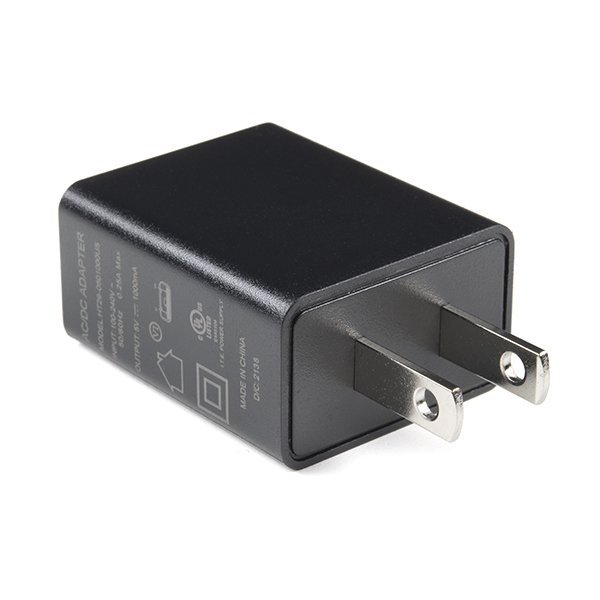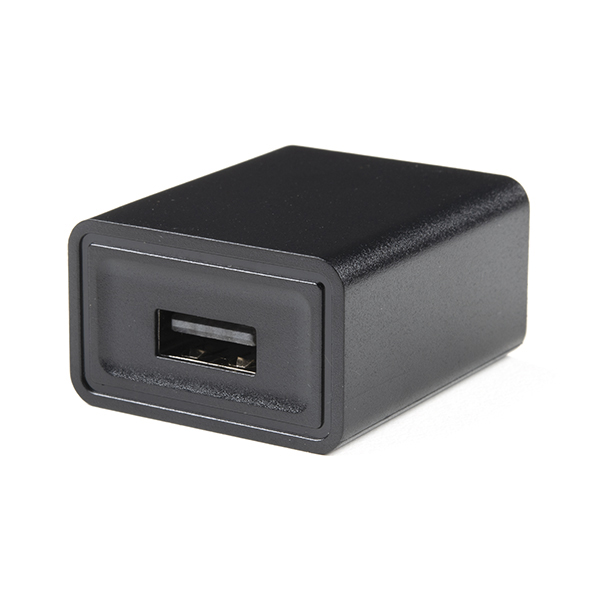USB is being implemented as a power connection standard more and more these days, but you don't always have a computer on hand so how are you going to power all of your sweet USB devices? How about a high quality switching 'wall wart'? This AC to DC power supply will do 5V at 1A! They're switch mode power supplies which means the output is regulated to 5V (no more 14V outputs!).
These have a standard USB 'A' connector for the output so you can power your Arduino, Raspberry Pi, etc. through a USB cable. Any device that uses a USB cable for charging or power can be powered with this supply.
Check out our Unregulated Power Supply Tutorial!
Note: This works with 100-240VAC inputs.
USB Wall Charger - 5V, 1A (Black) Product Help and Resources
How to Power a Project
February 7, 2013
A tutorial to help figure out the power requirements of your project.
Addressable LED Neon Flex Rope Hookup Guide
April 19, 2018
The addressable (UCS1903) LED neon flex rope adds cool lighting effects for outdoor and indoor uses including in hallways and stairs, holiday lighting, and more! In this hookup guide, you will learn how to connect, power, and control the LED segments with an Arduino and the FastLED library.
Qwiic Digital Indoor Thermometer
July 15, 2020
Qwiic-ly build a digital indoor thermometer to measure the ambient temperature of the room and display it using an OLED on an I2C bus!
Comments
Looking for answers to technical questions?
We welcome your comments and suggestions below. However, if you are looking for solutions to technical questions please see our Technical Assistance page.
Customer Reviews
4 out of 5
Based on 2 ratings:
4 of 4 found this helpful:
Pretty Close to USB Spec
I purchased 5 of these chargers in May 2015 and connected a dummy load of 800mA (5W 6.2 ohm resistor) to each to see how well they do under load. I viewed the voltage across the load using my trusty old HP54602B oscilloscope. The numbers were consistent across all 5 units: Avg: 5.28V (USB spec: 5.00) Min: 5.24V (USB spec: 4.75) Max: 5.32V (USB spec: 5.25) Ripple: 80mV. Ripple frequency is 33.3KHz.
Here's a screenshot of a typical waveform for this charger (don't mind the dust on the scope screen!): http://imgur.com/IRzHsIW
I've evaluated many chargers this way and I'd say this is a pretty good model. My desktop's USB provides 4.93V with a ripple of 20mV. Crappy 'free-gift' chargers provide about 5.2V with a ripple of 1 Volt (yes, 1 volt!). The charger that came with my Samsung phone was about the same as the one being reviewed here. All in all, two scope-probes up!
2 of 3 found this helpful:
It does what it says.
I have used this Wall Charger for both my Samsung Galaxy S5 and a Raspberry PI. I started by removing the plastic baggie, placed the prongs into a wall receptacle, inserted a USB cable, and connected my Raspberry... Boom! it booted up. I similarly connected the USB cable to my phone.. POW! the lightning bolt appeared on the battery icon in the right screen corner. I've been using this item since January 23, so far no wavering and no quitting... a true super-power. I recommend this item if you need to send power through a USB cable.



Are these 'high quality' wall warts better than the 12 volt ones that left the AC plug in the socket when I pulled it out?
yes.
I bought one of these and it broke after a year of very light use. When I plug a device into it now, the LED blinks and will not provide power.
Are these UL certified?
These are not UL certified and the label doesn't match that shown in the picture.
The conection between the female plug on the charger and any of the male usb cables I have is very flimsy and disconnects on the slightest touch.
Are not there of 2A?
Does anybody know how noisy these are? I'm planning on using these to power a raspberry pi to use in a home audio system and until I get a proper DAC, I will be using the built in audio and it is extremely susceptible to power quality. Has anybody tried these with an RPi and the onboard audio?
I haven't put these on a scope, but I am using one of them to run a bluetooth audio gateway. I bought a BlueGate product off of Amazon that was powered by a lithium polymer battery. The charging circuit died after owning it about a month and, to be honest, the battery feature was a pain in the butt. When you plugged in the charger, it would not function as an audio gateway at all - it would only charge the battery (when it worked).
I designed a simple circuit board to take the place of the battery, using a ldo regulator to drop the 5v incoming to 3.8 volts for the main circuit. I have about 20uF of capacitance on the output side and I can't hear any power supply noise making it through to the output. It may not be exactly the same scenario, but these are cheap enough that if it were me, I would just try it and see what happened.
Well, I went ahead and bought them to try, and the real testament to how well they work is that I didn't even think of the noise issue until I got an email notification saying you had responded to my comment!
I am using 5 of these to power Raspberry Pi B's where the analog audio outputs of the RPis are going into a pretty serious amplifier for home audio, and I can say that I haven't heard any noise whatsoever. I haven't scoped them, but I didn't need any special noise considerations, and even with the RPi output really low, and the amplifier all the way up, I don't even hear a hiss out of the speakers (like I was with another, low-quality power supply).
That being said, it would be awesome if you guys at Sparkfun would put up some form of measurement of "noisiness" on these kinds of power supplies (maybe Vpp_ripple or something like that). I've seen that a lot of people have been asking how noisy power supplies are.
Will this wall wart run a Raspberry Pi with a usb wifi adapter and Ethernet in use? I've had trouble with other suggested power supplies and definitively traced it to the wall wart being used.
Has anyone else had trouble using this with a raspberry pi + usb wifi NIC? I haven't yet measured the voltage drop, but I'm pretty sure you need 5.25volts to make up for the drop. I'm getting flaky results with the combination of my rpi + usb nic + this wall charger.
Some other OSH vendors sell 5.25v adapters specifically to solve a problem that occurs often with USB-powered gadgets: they draw so much current than the resistance of the cable causes a voltage drop.
You need more Amps not voltage. A typical Rasberry Pi fine with a 5v 1 amp USB wall charger. If you also trying to power a USB Wifi dongle, try finding a USB charger that supplies 2 or 3 amps. You may also want to plug the USB Wifi dongle into a powered USB hub and not the Raspberry Pi as the Raspberry Pi's current regulator can only take so much.
Does this supply short D+ to D- (through a small value resistor, or just directly) so that the device being charged can "know" it is capable of more than the default 500mA of USB ?
Thx.
Yes, D+ and D- are directly shorted.
Also, in a quick check of 3 units the no-load voltage varied from 5.18V to 5.20V and the voltage with a 1A load varied from 4.81V to 4.86V, which is well within spec and pretty good for a power cube that's this inexpensive.
In addition to the applications listed above, these would perfect for recharging your i-Racer.
Could you post a graph of output voltage vs. load current? Statisticians may chime in, but a "sample size" of something like "We checked two, and they were almost identical" would be enough to satisfy me.
AC ripple vs. load would be nice but not necessary. And now that I think of it, line regulation might be interesting...